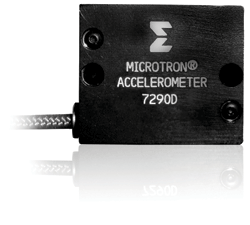A brief guide to selecting VC and PR accelerometers
Knowing the relative advantages of variable-capacitance and piezoresistive devices helps simplify design choices
BY BOB ROSENBERG
Endevco
San Juan Capistrano, CA
http://www.endevco.com
With the advent of variable-capacitance (VC) accelerometers and the continued availability of piezoresistive (PR) transducers, engineers now have a wider choice for their measurement needs. But VC devices seem to garner comments such as: “They are the same as PRs, so why change?” or “They are different and hard to understand, so I’m going to stick to what I know.” Therefore, a closer look at the relative merits of these technologies seems in order.

Technology differences
From an electrical or “black box” perspective, a VC transducer looks much like a PR device. That is, they both require an excitation voltage and output a voltage that is proportional to the applied acceleration. However, there are important differences.
VC devices operate largely independent of differences in excitation voltage and typically operate from an excitation of 9 to 30 Vdc with no output change. On the other hand, PR device output is ratiometric to the excitation voltage.
Internally, VC devices are quite different from PRs. While PR devices use strain gage technology to measure acceleration, VC devices use the change in capacitance derived from a moving plate. Also, the PR devices’ strain gages output voltage directly, while VC devices rely on sophisticated electronics to read the change in capacitance and output a voltage.
VC devices cannot be easily calibrated using shunt cal methods, but their sensitivity is often easily tested by simply using earth’s gravity as a 1-g reference.
VC devices have higher output than PR devices. For example, the full scale output of Endevco VC accelerometers is ±2.0 Vpeak , resulting is a high sensitivity, whereas Endevco PR devices are about ±200 mVpeak (with 10.00-Vdc excitation).
A PR transducer can be temperature compensated by adding resistors (in parallel or in series) whose temperature coefficients are the opposites of those of the bridge sensing gages. A VC device can be temperature compensated electronically. For instance, the Endevco 7290D is temperature compensated by observing the effect of temperature and compensating for it digitally. Digitally compensating VC transducers is orders of magnitude easier than solving the multiple equations with multiple unknowns that PR devices require.
Application differences
Basic application parameters often drive which type of device to select. Using the Microtron VC accelerometers as an example again, they are limited to 150 g or lessone measures ±2 g, full scale. But bear in mind that these devices have 20,000-g survivability due to their unique design. With their high sensitivity, VC devices are well suited for testing automotive suspension systems, measuring aircraft flutter, safety testing of amusement park rides, and control of specialized railroad passenger cars.
PR devices, with their capability of accurately measuring changes in acceleration greater than 60,000 g, are excellent shock accelerometers. As a result of a micromachined manufacturing process, they rarely exhibit zero shift, often found with piezoelectric accelerometers. Their low sensitivity makes them desirable for high-level shock events since they will provide accurate results without overdriving the associated data acquisition equipment.
Since PR devices are often dc coupled, they can capture long-duration shock events. They are the first choice for many transportation safety tests including automotive crash tests, airline seat safety, and head protection device test. So it can be seen that VC and PR devices are in many ways complementary. A summary of the advantages of each is given in the accompanying table . ■
| VC and PR accelerometer advantages | |
| Technology type | |
| Variable capacitance | Piezoresistive |
| • Excitation voltage independence (9.5 to 8 Vdc typical) • Overscale protection (20,000 g) • Line driving (50 to 500 Ω, vs. 500 to 1,000 Ω for PR) • High sensitivity • High accuracy over temperature • High output (±2 V full scale) | • Less noise (resistor noise only) • Broadly understood • Available in higher ranges • Small size • Less expensive • Low weight • Full scale is not absolute (VC FS electronically fixed; PR will work, not necessarily linearly, up to breakage point) • Ease of shunt cal (unnecessary with modern amps, but still in use) |
For more on accelerometers, visit http://www2.electronicproducts.com/Components.aspx.
Advertisement
Learn more about Meggitt Sensing Systems





